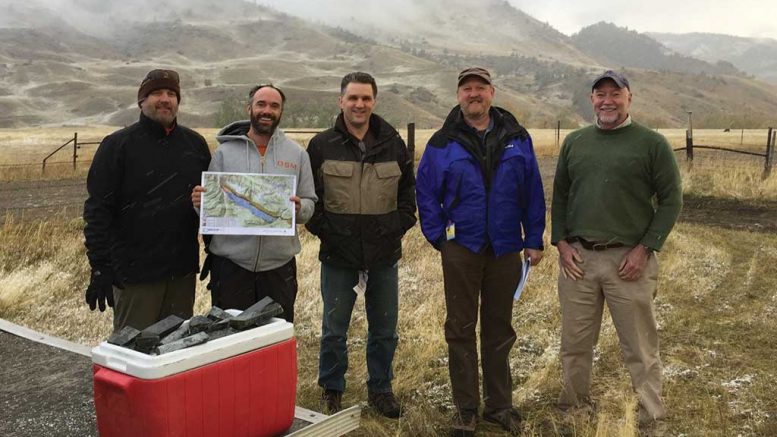VANCOUVER — It would be rare to find a geologist who went through university without studying the Stillwater complex in southern Montana. The complex is a world-class example of layered mafic intrusion deposits — similar to those seen in South Africa’s Bushveld region or Russia’s Noril’sk deposits — and contains some of the planet’s highest reserves of platinum group metals (PGM) and chromium.
Which is why Group Ten Metals (TSXV: PGE; US-OTC: PGEZF), a B.C.-based junior active in PGM-nickel-copper exploration in the Yukon and gold in Ontario, couldn’t resist staking 23 sq. km of claims alongside Sibanye-Stillwater’s (NYSE: SBGL) Stillwater mine complex in June, only to add 17 sq. km more to its position on Nov. 15.
Michael Rowley, Group Ten president and CEO, told The Northern Miner during a phone interview from the sidelines of the Silver and Gold Summit in San Francisco that exploring for PGM-nickel-copper deposits at its Stillwater West project has become the company’s top priority.
“Putting ourselves in that iconic pen is the best thing we ever could’ve done. A lot of people have started to notice us, and as we get talking to them, they learn there’s a lot more there than just a star on the map,” Rowley said.
The district saw renewed interest in December 2016, when South African producer Sibanye Gold — now Sibanye-Stillwater — launched a US$2.2-billion deal to acquire Stillwater Mining for its three underground PGM mines: East Boulder, Blitz and Stillwater.

Group Ten Metals’ land package parallels Sibanye-Stillwater’s Stillwater mine complex in Montana. Credit: Group Ten Metals.
The mines have produced over 12 million oz. palladium and platinum since 1986, making the Stillwater complex the largest primary PGM producer outside South Africa and Russia.
The complex still contains 31.3 million oz. platinum-palladium at 17 grams per tonne in the measured and indicated category and 49.2 million oz. platinum-palladium at 16.6 grams in inferred. The average split is 78% palladium to 22% platinum.
As Sibanye closed its acquisition, Rowley said Group Ten began staking ground “in case Sibanye was thinking of doing it themselves.” In doing so, he said Group Ten inherited an enormous amount of historical data dating to the 1970s.
“The data kept pointing us to acquire new ground, which is why we had a second round of staking nearly doubling the size of the property,” Rowley said. “Now we’re in a position where we can finally start talking more about the property and laying out the narrative.”
Large volumes of magma in the Stillwater complex were intruded into the crust 2.7 billion years ago. Over time, slow cooling and mixing of magma blanketed layers of chromium, PGM, nickel and copper-enriched rock across the 5.5 km thick rock package.
Today, the most prolific PGM occurrence at Stillwater is found within the 2-metre-thick J-M reef that can be traced for 48 km discontinuously along strike, dipping to the northeast.

Sibanye’s underground Stillwater PGM mine near Nye, Montana, in the United States,
The bulk of Group Ten’s land claims run parallel to the J-M reef, covering the deeper parts of the basin where nickel-copper and chromium occurrences are more prolific, Rowley said. A small string of Group Ten claims also cover the Picket Pin PGM reef, which is found 3 km stratigraphically above the J-M reef.
“Nickel-copper and PGM exploration will be the focus for us,” Rowley said. “Previous explorers tagged into these systems in 2004 and surprised themselves with these large bodies of disseminated mineralization, but they ran out of gas because the markets at the time weren’t in their favour.”
Rowley said most of the previous work in the district focused on the J-M reef, in part because of the “spectacular grades,” while the rest of the basin has been largely overlooked.

Nickel-copper-PGM mineralization in historic core from the lower Stillwater Complex on Group Ten Metals’ Stillwater West project in Montana. Credit: Group Ten Metals.
“There wasn’t a recognition until the mid-2000s that the lower part of complex had potential to host significant PGM deposits that occur with higher nickel-copper than what you would see in the J-M reef,” he said. “We believe we are ideally positioned for a major new discovery here.”
The company intends to start drilling this year.
“Stillwater West will become the flagship,” Rowley said. “There’s a lot to be done here and we have an enormous step up with the data we’ve received.”
Shares of Group Ten have traded in a 52-week range of 8¢ to 24¢, and closed at 22¢ at press time. There are 39.8 million shares outstanding for a $9-million market capitalization.


Be the first to comment on "Group Ten acquires claims in Stillwater complex"